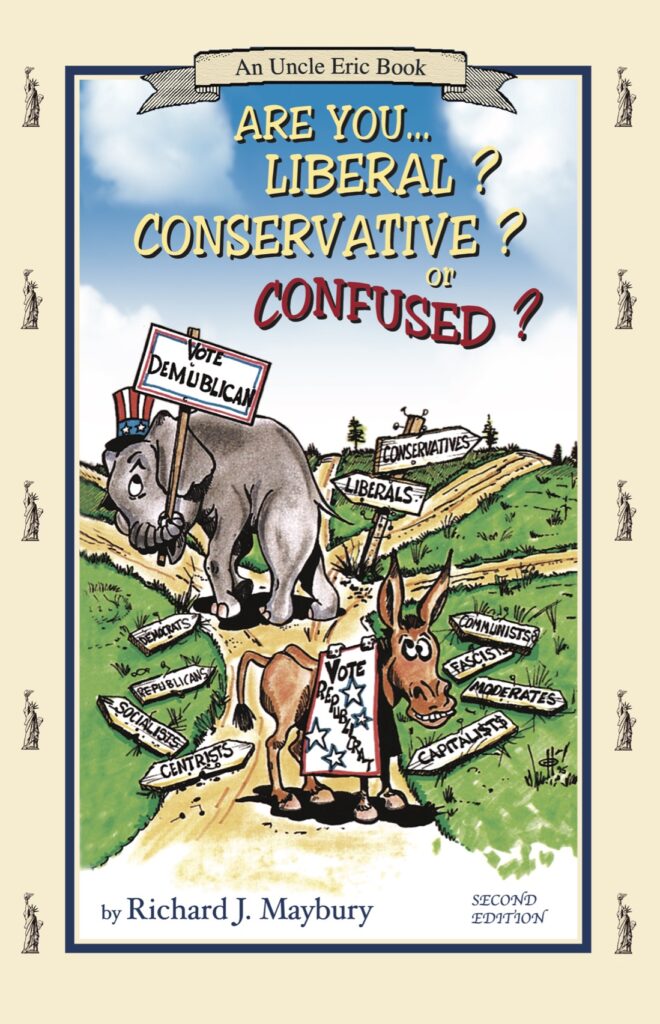
Uncle Eric Series book 4 of 11
Are You Liberal? Conservative? or Confused?
by Richard J. Maybury
2nd Edition
ISBN-13: 978-0-942617-54-2
ISBN-10: 0-942617-54-1
© 2004
Cover Price $14.95
Paperback. 144 pages, quality paper, 8.5 x 5.5 inches.

Reading Level
Ages 13 through Adult.

Course Uses
Can be used for courses in Government, Civics, Election Unit Studies, Economics, Business, Finance, History.
Description
Are You Liberal? Conservative? or Confused? by Richard J. Maybury discusses political labels: Liberal, conservative, left, right, democrat, republican, moderate, socialist, libertarian, communist — what are their meanings and economic policies, what plans do their promoters have for your money, and what model do they follow?
Are You Liberal? Conservative? or Confused? contains clear, concise explanations. Explanations of facts and fallacies. And raises the question: Does inconsistency to the original American philosophy endanger liberty?
Using the epistolary style of writing (using letters to tell a story), Mr. Maybury plays the part of an economist (Uncle Eric) writing a series of letters to his niece or nephew (Chris). Using stories and examples, Mr. Maybury gives interesting and clear explanations of topics that are generally thought to be too difficult for anyone but experts.
Mr. Maybury warns, “beware of anyone who tells you a topic is above you or better left to experts. Many people are twice as smart as they think they are, but they’ve been intimidated into believing some topics are above them. You can understand almost anything if it is explained well.”
Table of Contents
Uncle Eric’s Model of How the World Works
Author’s Disclosure
1. Don’t Be Embarrassed
2. The Original American Philosophy
3. The Opposite of the Original American Philosophy
4. Basic Political Spectrum
5. The Nature of Political Power
6. The Two Categories of Encroachment
7. The Middle Ground
8. Freedom vs. Liberty
9. Exceptions
10. Military and Foreign Policy
11. Democrats and Republicans
12. Socialism and Communism
13. Fascism
14. What Are They Really?
15. The Other Middle View
16. The National Religion
17. A U.S.-Nazi Alliance or a U.S.-Soviet Alliance?
18. Economic Counterparts
19. Effects on Your Money
20. Three Types of Wrongdoing
21. Muddied Waters
22. Who Gets the Children?
23. The Return of Racism
24. The First American Philosophies
25. Summary
26. Encroachment, Big and Small
Bibliography
Book Suppliers
Glossary
About Richard J. Maybury
Index
Curriculum Packages
This title is included in the following curriculum packages:
•Nature of Government and Civics Course for High School Students
•Economics and Nature of Government Course for High School Students
Reviews
“Are You Liberal, Conservative, or Confused? is an outstanding primer for political studies. Parents and children will have much food for thought in this easy-to-read volume that covers much more than just terms. Short chapters allow the student to learn the material a little at a time.”
—Martha Robinson, Reviewer for HomeschoolChristian.com
“Like our previous Maybury favorites (Whatever Happened to Penny Candy? and Whatever Happened to Justice?) in Are You Liberal? Conservative? or Confused? Uncle Eric leaps to the rescue firing off 26 thoroughly fascinating letters on political philosophies, past, present, and future. The book is recommended for readers aged 14 and up, but I’d crank it down a few years – Uncle Eric is clear as a bell.”
—Becky Rupp, Good Stuff, Home Education Magazine
“The entire series should be a required, integral component of the social studies curriculum in all public and private schools.”
—William P. Snavely, Emeritus Professor of Economics, George Mason University
“I have read your book Are You Liberal? Conservative? or Confused? I really enjoyed it. It really helped me understand what was going on in the news with the election…My whole family really enjoyed your book. We told all of our neighbors about it, and now, they want to read it. It is going to be passed all around our Church too. It was really a fun way to learn some pretty confusing things. It was much better than reading it out of a text book!”
—A.B. (age 13)
Awards
Over the past several years, The Uncle Eric Series has won awards in both the Government and Worldview Curriculum categories of Mary Pride’s Practical Homeschooling® Reader Awards™. These awards are determined based on votes from readers. We are especially honored by these wins, as the awards were based — not just on popularity — but on the readers’ satisfaction. For all those who have voted over the years: Thank you!
“Your books (the Uncle Eric books) are among the few I recommend for every high-schooler as ‘must reads’ before graduation.”
—Mary Pride, Publisher of Practical Homeschooling®

